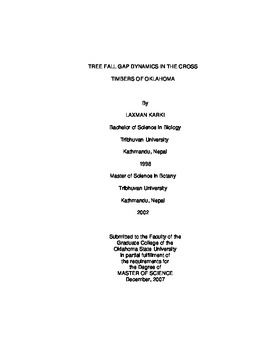| dc.contributor.advisor | Hallgren, Stephen W. | |
| dc.contributor.author | Karki, Laxman | |
| dc.date.accessioned | 2014-04-15T21:59:47Z | |
| dc.date.available | 2014-04-15T21:59:47Z | |
| dc.date.issued | 2007-12-01 | |
| dc.identifier.uri | https://hdl.handle.net/11244/9179 | |
| dc.description.abstract | This study was carried out to determine the effects of tree fall gaps on forest composition in the Cross Timbers of Oklahoma. The three hypotheses of major importance in this study were (1) the proportion of gap makers from a species is the same as the proportion of that species in the canopy of the closed forest, (2) gap size has no effect on regeneration of canopy tree species and (3) the gap maker replacement probabilities by gap fillers are such as to maintain the presence of dominant species in the stand at the current levels. The results show that the proportion of blackjack oak (Quercus marilandica) was higher for gap makers than the canopy of closed forest. There was no effect of gap size on regeneration density. Blackjack oak may be declining and post oak (Q. stellata) may be increasing in the forest due to gaps. | |
| dc.format | application/pdf | |
| dc.language | en_US | |
| dc.publisher | Oklahoma State University | |
| dc.rights | Copyright is held by the author who has granted the Oklahoma State University Library the non-exclusive right to share this material in its institutional repository. Contact Digital Library Services at lib-dls@okstate.edu or 405-744-9161 for the permission policy on the use, reproduction or distribution of this material. | |
| dc.title | Tree Fall Gap Dynamics in the Cross Timbers of Oklahoma | |
| dc.type | text | |
| dc.contributor.committeeMember | Will, Rodney | |
| dc.contributor.committeeMember | Palmer, Michael W. | |
| osu.filename | Karki_okstate_0664M_2561.pdf | |
| osu.college | Agricultural Sciences and Natural Resources | |
| osu.accesstype | Open Access | |
| dc.description.department | Department of Natural Resource Ecology and Management | |
| dc.type.genre | Thesis | |
